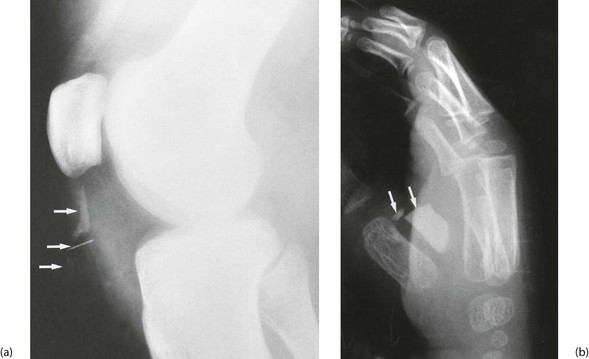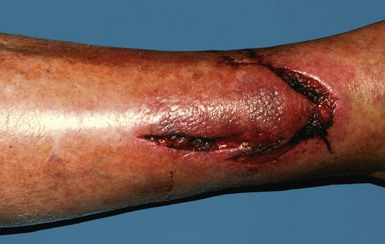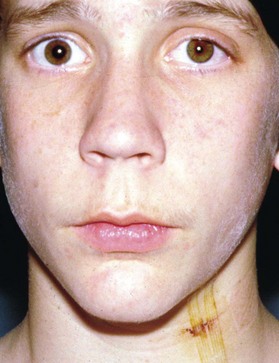Soft tissue injuries and burns
Soft tissue injuries
Soft tissue injuries are defined here as cuts, lacerations, crushing injuries, missile injuries and impalements not involving bone or body cavities. The priority for treating soft tissue injuries depends on the primary survey determined by the ABCDE system (Ch. 15).
The management of a soft tissue injury depends upon the following factors:
• The mechanism of injury (e.g. penetrating knife wounds, lacerations in road crashes, blast injuries, gunshot and missile injuries, burns, bites)
• The extent and depth of wounds
• The types of tissue involved including nerves and blood vessels
• The extent of tissue devitalisation
• Any contamination (e.g. with road dirt, soil or potential bacterial inoculation with animal or human bites)
Intermediate soft tissue injuries
Foreign bodies: The history of the injury can indicate the likelihood of foreign bodies being retained in the wound. The main types are agricultural and road dirt, wood splinters, and glass and metal fragments. Plain radiology reveals metal and usually glass (see Fig. 17.1) but a negative X-ray does not exclude its presence. Remember that a foreign body unrecognised at the time may result in litigation later.
Flap lacerations: Relatively minor trauma to the tibia commonly produces a V-shaped flap laceration (Fig. 17.2) particularly in older patients or in patients on long-term corticosteroids. If untreated, this injury habitually fails to heal because of poor blood supply to flap and underlying tissue. Attempting to suture or tape a flap into place increases tension, causing ischaemia, tissue loss and ulceration. The most effective management is early excision and immediate split skin grafting. This can be performed under local anaesthesia and takes an average of 2 weeks to heal.
Facial lacerations: Minor facial lacerations heal well and can be primarily sutured in the accident department after careful cleaning. Infection is rare because of the excellent blood supply. Even ragged skin edges do not become devitalised and trimming is rarely necessary. The main consideration is the cosmetic outcome, so great care should be taken with technique, employing general anaesthesia if necessary. Complex lacerations, lacerations across the lip margin or eyelid and areas of substantial skin loss, especially on children and young people, should ideally be managed by plastic surgeons (see next section).
Scalp lacerations: With scalp lacerations, brain injury and skull fracture must be excluded and then determine whether the aponeurotic layer (galea) has been breached. Haemostasis must also be achieved; it is easy to underestimate blood loss from scalp lacerations, sometimes sufficient to cause hypovolaemic shock in the elderly. Assessment and thorough exploration is made easier by shaving the wound edges; large lacerations may need exploring under general anaesthesia. If the aponeurosis is breached, it should be repaired separately to prevent a subaponeurotic haematoma vulnerable to infection. Care should be paid to haemostasis from major scalp blood vessels lying in the superficial fascia between dermis and aponeurosis. Dense collagenous bands cross the area and can prevent torn vessels contracting, hindering the spontaneous arrest of bleeding. Torn vessels need to be individually ligated or sutured.
Major soft tissue injuries
Major injuries of soft tissues alone requiring hospital treatment are uncommon and can be classified as in Box 17.1. A primary survey (Ch. 15) determines the order injuries are managed, with life-threatening injuries treated first. For other injuries, the urgency depends on the potential for deterioration (e.g. blood loss, ischaemia or loss of an eye), the risk of infection and the availability of the necessary specialists. Contused or contaminated wounds need early cleansing and excision of all devitalised tissue (debridement), usually under GA. If substantially contaminated, wounds are often left unsutured to prevent wound infection and are then sutured a few days later by delayed primary closure. Less commonly, wounds are left open and are allowed to heal by secondary intention (see Ch. 3, p. 36). Wounds involving skin loss may need early skin grafting.
Injury to a vital part of the body
Eye: Injuries greater than ‘sand in the eye’ are best managed by ophthalmic specialists who require a slit lamp and other instruments to assess the injury. Typical injuries include abrasions to the cornea, penetrating injuries (dart or pellets) and firework injuries.
Neck: Penetrating injuries to the neck must be treated with respect. Vital structures are concentrated here and may be injured. These include major arteries and veins (carotid, jugular, subclavian, vertebral), the brachial plexus, some cranial nerves, the cervical sympathetic chain (see Fig. 17.3), and lung and pleura.
Lacerations to the limbs and hands: (for Traumatic amputation, see p. 236)
The main considerations with this type of injury are:
• Possible nerve, tendon or vascular injury—assessment includes testing sensation, movement, peripheral pulses and tissue perfusion (i.e. pulses, warmth, colour, capillary refilling after blanching). Tendon and nerve injuries are covered below
• Tissue viability—particularly important in crush injuries and flap lacerations such as in the pretibial area (see above)
• Risk of infection—the fingers and hands are vulnerable to infection of pulp spaces and the deep palmar space. Wounds need antibiotic prophylaxis against staphylococci and streptococci (e.g. flucloxacillin plus amoxicillin). They also need meticulous cleansing and exploration, if possible by a specialist hand or plastic surgeon. Injuries from bites (especially by dogs or humans) and bones (usually in meat workers) almost invariably become infected (see below).
Extensive facial lacerations: Facial injuries should be thoroughly cleaned and examined under local or general anaesthesia to determine the extent of the damage before repair; ideally within 12 hours of injury. Facial wound edges need minimal trimming. Important anatomical boundaries should be aligned first; these include the vermilion border of the lip, the rim of the eyelid and the eyebrow. Tissue layers should then be approximated individually—mucosa, muscle, cartilage and skin. Parotid duct injury should be considered in deep lacerations of the cheek and the duct repaired if possible. Photographic documentation is useful to help the patient appreciate the extent of injury and to provide an accurate record of progress.
Vascular injuries involving blood loss or ischaemia
Compartment syndrome: The muscles of the leg below the knee and in the forearm lie within rigid fascial compartments. Delayed restoration of blood flow after ischaemia leads to reperfusion injury, which allows protein-rich fluid to leak from damaged capillaries. The intra-compartmental pressure rises (normally in the range of 0–10 mmHg) which compromises venous flow and later reduces capillary flow. This initiates a vicious circle that exacerbates the ischaemic insult and further increases the pressure. Arterial inflow is not usually impaired but compartment syndrome rapidly leads to irreversible nerve ischaemia and muscle necrosis.
Animal-associated soft tissue injuries
Snakebite: Poisonous snakes are a hazard in many areas, although deaths from snakebite are rare. Snakebites are most common where dense human populations coexist with large snake populations (e.g. South-East Asia, sub-Saharan Africa, and tropical America). Highly dangerous snakes include the Australian brown snake; Russell’s viper and cobras in southern Asia; carpet vipers in the Middle East; and coral snakes and rattlesnakes in the Americas. The venom of a small or immature snake can be even more concentrated than that of larger ones; therefore all snakes should be left well alone. Less than half of all snakebite wounds actually contain venom, but travellers are advised to seek immediate medical attention whenever a bite breaks the skin. First-aid measures should include immobilising the affected limb and applying a pressure bandage that does not restrict limb perfusion (not a tourniquet), then moving the victim quickly to a medical treatment centre. Incision of the bite is not recommended. Specific therapy varies and should be left to the judgement of experienced local emergency personnel.
Arthropod bites and stings: The bites and stings of some arthropods (which include insects) can cause unpleasant reactions. Travellers should seek medical attention if a spider or insect bite or sting causes excessive redness, swelling, bruising or persistent pain. Patients with a history of severe allergic reactions to bites or stings should consider carrying an adrenaline (epinephrine) autoinjector (EpiPen). Many insects and arthropods can transmit communicable diseases, even without the traveller being aware of a bite, particularly when camping or staying in rural accommodation. Travellers to many parts of the world should be advised to use insect repellents containing DEET, protective clothing, and mosquito netting around beds at night. Stings from scorpions can be painful but are seldom dangerous except in infants and children. Exposure to scorpion stings can be avoided by sleeping under mosquito nets and by shaking clothing and shoes before putting them on.
Animal bites: Domestic pets cause more bites than wild animals, with dogs more likely to bite than cats; however, cat bites are more likely to become infected. Their sharp pointed teeth cause puncture wounds and lacerations that may inoculate bacteria deeply. In Adelaide, about 6500 people are injured each year by dog attacks and 800 seek hospital treatment (7.3 per 10 000 population). Some 90% of children who were bitten suffered head and facial bites. In the USA, dog bites cause about 44 000 facial injuries requiring hospital treatment and 10–20 people are killed each year. This is about 1% of all emergency room visits. In the UK there was an average of 2.3 fatalities a year between 1999 and 2004. Unfortunately, most fatalities are in young children where bites to the face, neck or head are extremely hazardous. Children are often bitten in these areas because of their small stature.
The principles of treatment of bite wounds are inspection, debridement, irrigation and closure:
• Wounds should be inspected to identify deep injury and devitalised tissue. This nearly always requires a general or regional anaesthetic. Care should be taken to visualise the deepest part of the wound and to examine the wound through the range of motion
• Debridement is an effective means of minimising infection. Devitalised tissue, particulate matter and clots should be removed, as with any foreign body. Clean surgical wound edges result in smaller scars and promote faster healing
• Irrigation also helps prevent infection. A 19-gauge blunt needle and a 50 ml syringe provide enough pressure and volume to clean most wounds. In general, 100–200 ml of irrigation solution per cm3 of wound is required. Large, dirty wounds need to be irrigated in the operating theatre. Saline solution is effective and inexpensive
• Primary closure can be considered in clean bite wounds or wounds that can be cleansed effectively. Others are best treated by delayed primary closure. Facial wounds are at low risk for infection, even if closed primarily. Bite wounds to the lower extremities, bites where there is a delayed presentation, or those in immunocompromised patients should generally be left open
Types of infection: Animal saliva is heavily contaminated with bacteria; over 130 disease-causing microorganisms have been isolated from dog and cat bites, thus nearly all infections are mixed. In rabies areas, bites from non-immunised domestic animals and wild animals carry the risk of rabies and the need for prophylaxis should be considered, in addition to tetanus prophylaxis. While local infection and cellulitis are the leading causes of morbidity, sepsis is a potential complication of bite wounds. Meningitis, osteomyelitis and septic arthritis are additional concerns in bite wounds. Rabies is a generally fatal complication. However, the three infections mentioned below are probably the most significant:
Pasteurellosis: Pasteurella multocida is a bacterium carried naturally by most mammals in their mouths, including healthy cats, dogs and rabbits, and by some birds and fish. The organism is responsible for the most common bite-associated infection. The first signs of pasteurellosis usually occur within 2–12 hours of the bite and include pain, reddening and swelling of the area around the bite. Pasteurellosis can progress quickly, spreading from the bitten area, and may cause flu-like symptoms such as fever, headaches, chills and swollen glands. If left untreated, it can cause pneumonia or systemic sepsis and, on rare occasions, death.










